Make People Awesome … using the Flow Leadership Framework!
One of the four key areas on which Modern Agile focuses is “Make People Awesome.” To help make people awesome is a humbling journey to undertake. However, the phrase itself may add to some of the confusion traditional management has regarding Agile and Agile methodologies.
We’re not aware of any successful leadership or management paradigm that “makes people” do anything. That being said, we love creating the environment and ecosystem that allows individuals, teams and organizations to achieve sustainable, high-performance creating remarkable results.
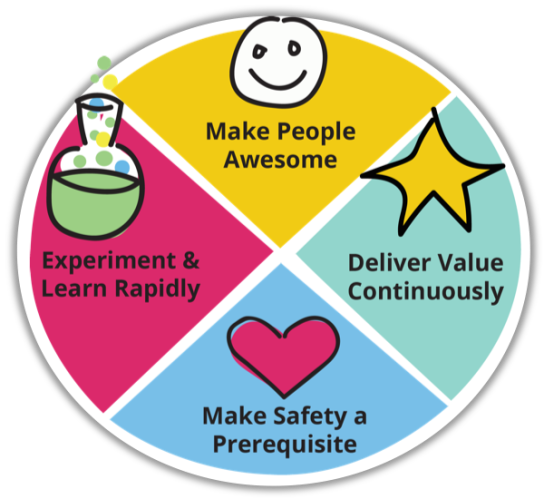
Delivering remarkable results related to the customer’s and organization’s Vision is one of the key elements of Flow. Our assumption is that if you are reading books like Flow, Drive, Start with Why, Turn the Ship Around, Brick by Brick, and so on, then you are already on your way to becoming (and being) “awesome.” However, we can’t make you read those books or change your attitude, approach or behaviors to customers, other people, and your work product.
We begin with people (and the individual’s Vision) in Flow, since they are core to the successful delivery of business value. It stands to reason, then, that the more “awesome” people that you have on your team, the higher the probability is that you will achieve remarkable results.
If you want to know how to successfully guide people in their journey to becoming awesome, you will need some additional tools in your toolkit. In Flow, we use a number of models and tools to support and guide people in their journey to becoming truly awesome. One of the tools we use in Flow is the Aha! Curve:
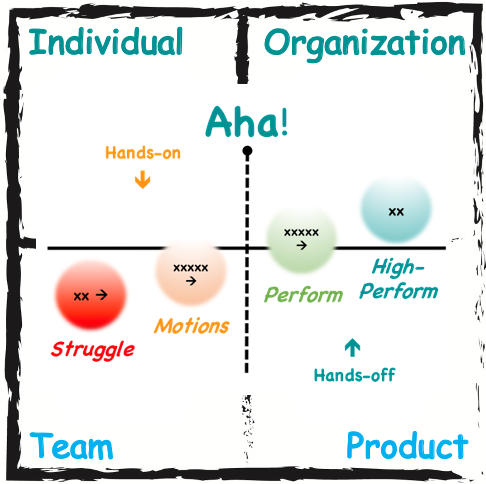
Knowing about Agile (Flow, Kanban, Scrum, XP, etc.) is part of the first two steps in the Aha! Curve pictured above. Everyone struggles when first learning how to use any Agile approach. And, even if an individual is only “going thru the motions,” they are still making progress towards the goal of being Agile.
But, merely “knowing” about Agile is not enough. A person also needs to be able to demonstrate competence in using & being Agile.
The other two steps in the Aha! Curve occur when individuals and teams can actually demonstrate continuous and sustainable improvement. They are no longer just going through the motions, but rather, the light of understanding has turned on and they have achieved what we call the “Aha! Moment.”
They not only understand Agile but have actually internalized the values and can now consistently apply those values in their daily work. The awesome nature of a high-performing individual or team, many times, is an organic outcome of practicing Agile approaches and developing an Agile mindset. However, it is not guaranteed; and, it cannot be forced into existence. Flow provides an environment and a holistic leadership ecosystem that allows “awesome” to occur.
Every person is unique and the journey up the curve to their “Aha!” moment can be fairly quick or take years. At the same time, every Team needs to go through the same journey. Same for each Product (Program, Process, Project) as well as for the entire Organization as shown in the following transformational four-box. Flow combines a modification of the “four windows on transformation” (Lyssa Atkins and Michael Spayd, Scrum Gathering 2013) with our Aha! Curve:

We believe that the picture above is why Jeff Sutherland and Ken Schwaber point out in “Software in 30 Days” that the journey to transform an entire organization takes up to five (5) years. Using Flow, we can reduce that transformation down to a couple of years. And, you cannot do a transformation in one area without impacting or touching the other three.
If you do not understand the time required for a successful transformation, then you dramatically increase the odds that you will not achieve awesome results. Also, the two areas on the right in the picture above deal with politics.
Many Agilists haven’t understood the political part of the equation; or, that politics is a full-contact sport. Here’s a recent video clip of an Agile Coach (Jayme) that had tried to become an Enterprise Agile Coach; but, he became frustrated with organizational “politics” and decided to go back to being a Team Coach (you only need to listen to around the first 2 min 30 sec to get the gist of his dissatisfaction):
What Jayme misses is that successful team-level practices do not scale to the Executive Suite. There are repeatable frameworks for dealing with politics and Leadership issues. That’s what Flow is all about. He exemplifies the typical Agile coach who assumes that what worked well at the team level will also work well at the organizational level. This is simply not the case.
A good Enterprise Agile Coach is also a really good Management Consultant. I can already hear the boos and jeers that will erupt from the Agile side of the house; but, a successful Enterprise Agile Coach lives between the two worlds of Agile Coaching and Management Consulting:
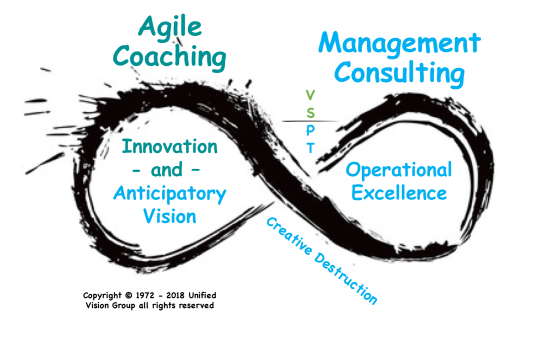
On the one hand, an Enterprise Agile Coach needs to be able to help build a culture of Innovation and Anticipatory Vision (click link to see our blogpost on that).
On the other hand, an Enterprise Agile Coach needs to also be able to help build a culture of Operation Excellence. It’s a “both-and” not an “either-or” proposition. One of the greatest values that a really good Enterprise Flow Coach will bring to the table for an organization is to help the Operational Excellence side of the equation understand when it is time for “creative destruction.”
A successful Enterprise Flow Coach understands you don’t need everyone onboard with when scaling Agile in an organization to have a very successful “scaling” result. The reason for that is that incrementally moving everyone up the Aha! Curve consistently over a couple of years (i.e. Train-Coach-Mentor) will easily double an organization’s ability to deliver value, even if everyone isn’t onboard with going through the Agile journey.
That’s what “scaling” Agile is all about and it’s actually understanding the law of averages at both the Program and Portfolio levels – check out Andrew’s article on “The Art of Portfolio Management from a Fund Manager’s View:”
https://www.linkedin.com/pulse/flaw-averages-agile-portfolio-mgt-using-fund-managers-andrew-kallman/
Another tool we use in Flow when working with Individuals is the 4R Model:
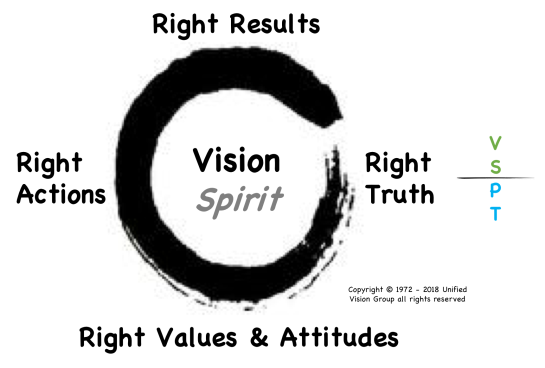
In order to help people on their journey to being Agile, we need to start with the Vision that the individual has since it is central to understanding a person’s motivation. Everyone distills their personal Values and Attitudes based on what they have as their “Truth.” A person’s core “Truth” and “Values and Attitudes” are demonstrated via the actions that a person chooses to take. Hopefully, this leads to “Right Results.”
However, if you are consistently getting the “wrong” results from an Individual or Team, then you might want to use the 4R Model in reverse (as a root-cause analysis tool):
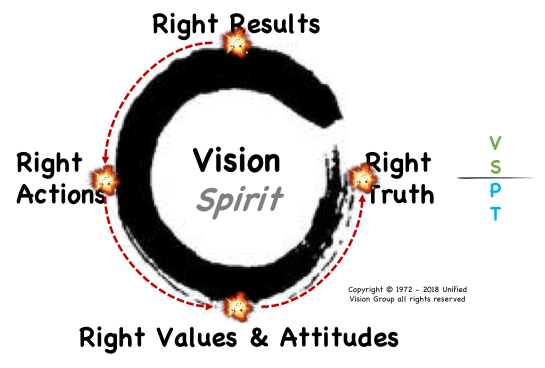
If you didn’t get the intended Result, then you’ll want to look at the Actions. Behind those actions were Values and/or Attitudes that were based on some “Truth.” It might be necessary to look at training, coaching and/or mentoring (depending upon the situation) in order to get the person back on the right track.
To support and guide a person in their journey, we need to understand that sometimes life happens. We use the following diagram as a simple and quick way to coach and mentor our team members:

Good leaders master the art of asking questions. If you notice a downward trend in a team or individual’s performance, like any good coach you might want to begin to ask questions and/or listen for signals from your co-worker in the following areas:
- Spirit – “Is your Vision clear?”
- Mental – “What are you doing to grow yourself mentally?”
- Physical – “Do you feel confident in your health regimen?”
- Social – “How are your relationships?”
The “spirit” area might seem like an odd area to chat about at work, but we need to work with people holistically; and, that begins with the individual’s Vision. For example, back in 2018 the following post came across Mia Kolmodin’s LinkedIn feed from Johan Victor:
To everyone stressed out there, maybe we need a new definition of success? David W Orr shared:
“The plain fact is that the planet does not need more successful people. But it does desperately need more peacemakers, healers, restorers, storytellers, and lovers of every kind. It needs people who live well in their places. It needs people of moral courage willing to join the fight to make the world habitable and humane. And these qualities have little to do with success as we have defined it.”
This quote took my breath away! Got this yesterday from my new favorite writer, author, poet Frida Spikdotter Nilsson. Thank you, Frida!
Clearly Frida intuitively understands the 4D Model from Flow, even though she most likely has never seen it:
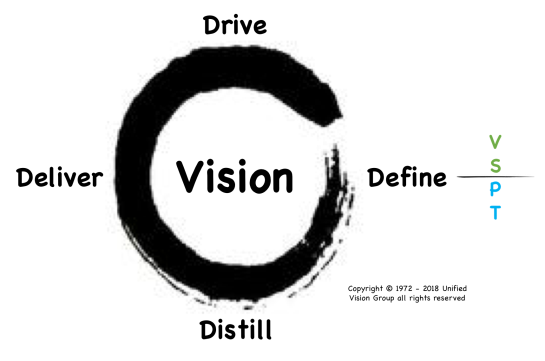
Definitions are always the starting point for success. But, before you can Deliver, the team needs to Distill agreement on their agreed-upon Definitions. In Flow, a team might define Frida’s list in the following way:
- Peacemakers understand how to use Vision to unite people where division (literally “two visions”) exists. This is one of the most concrete and powerful uses of Vision and the Cascading VSPT (Vision, Strategy, People, Results) – see our blog post on the Power of the One Thing.
- Healers understand the social, mental, physical and spiritual aspects of each individual, team and even for an entire organization.
- Restorers have mastered the art of forgiveness and rebuild what has been torn down (either intentionally or accidentally).
- Storytellers know and understand the power of the tribal story as a great tool for uniting, energizing and inspiring the team as well as for the entire organization.
- Lovers express and demonstrate through their actions that the greatest item in this list … is Love. We define love as selfless giving or true “servant leadership.”
Making people awesome is a long-term investment in building people’s lives by supporting and inspiring them to pursue personal excellence in a sustainable way. It takes love, perseverance and moral courage to make this commitment. And, we need to begin where people are, not where we wish they were.
That’s the whole point of Flow, the Aha! Curve, the transformational four-box (what we now call the 4 Lenses in the Flow Leadership Framework), the 4R Model; and, the 4D Model. Hopefully these mindsets and ways of thinking will make your world Flow towards being a little more inviting, habitable, humane and successful!
Life is short. May we all be awesome.
__________
For those that are not familiar with the Flow Leadership Framework, it is what’s next for businesses and organizations that are ready to succeed regardless of the methods, frameworks or management tools that they use throughout their enterprise. Flow is methodology agnostic.
Are you ‘in the zone’ of optimal performance right now as a person, team or enterprise? Did you get there by accident or by focused intentional acts?
Flow gives you the tools and practices needed to create and maintain an optimal state of high performance as an individual, team or organization. Flow turbocharges whatever you are using: Agile 2, Modern Agile, “business agile” leadership, Scrum, Kanban, Lean, SAFe, etc.
__________ __________
PS Here are the associated links to this blog post for:
#culture #scrum #agile #pmi #pmp #kanban #lean #flow #scaledagile #transformation #change #transform